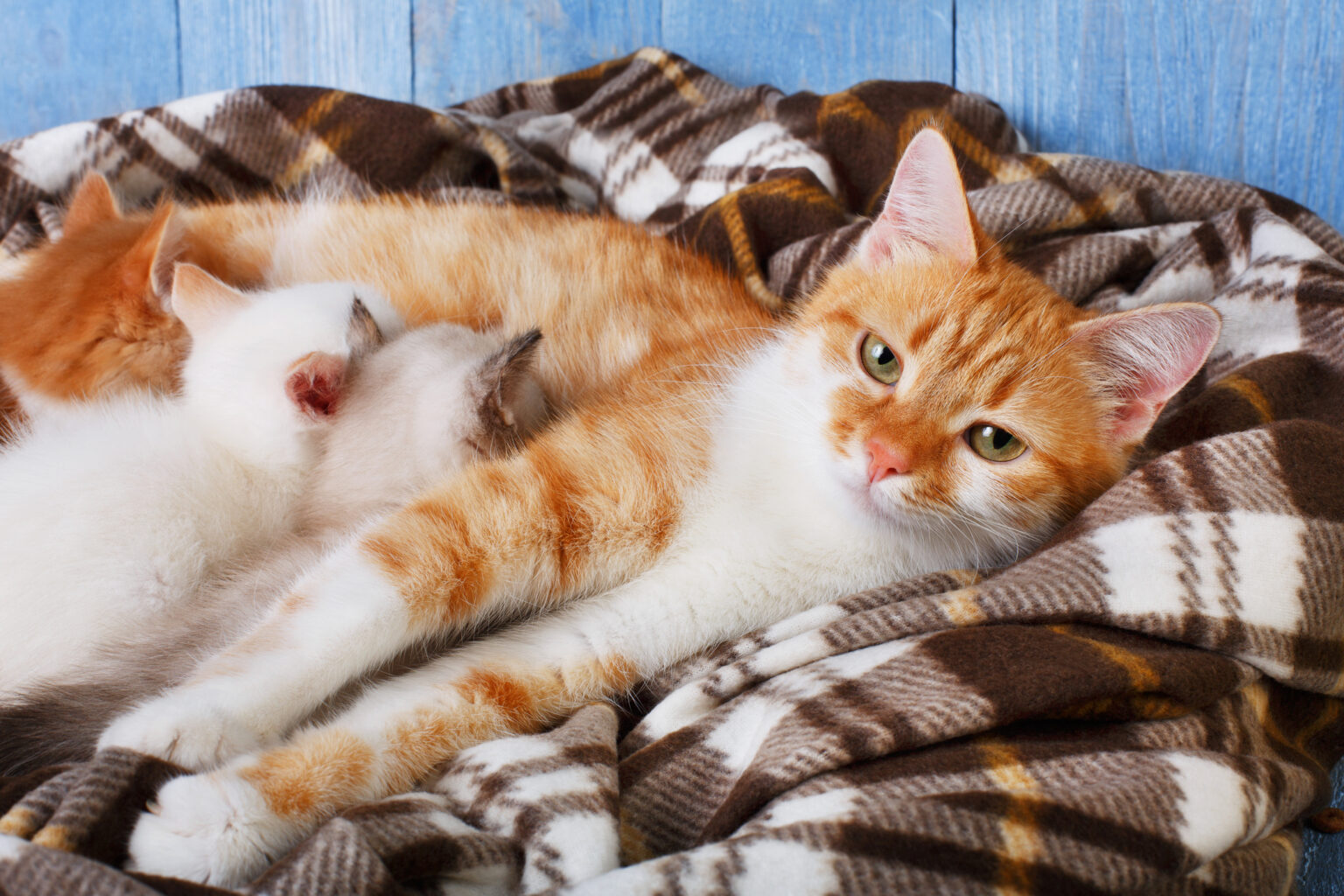Although most cats deliver their litter without any assistance, problems can occasionally arise which require the attention of a vet. Always seek veterinary advice if any of the following occur:
- Twenty minutes of intense labour without a kitten being delivered.
- After ten minutes of intense labour, a kitten or a fluid-filled bubble is visible in the birth canal, but not progressing.
- The mother experiences sudden depression or marked lethargy.
- Elevation of body temperature exceeds 103°F (39.4°C).
- Fresh blood discharges from the vagina for more than 10 minutes.
Difficulty delivering (dystocia) may be managed with or without surgery. This will depend on the condition of the mother as well as the size of the litter and of the kittens.
Problems during pregnancy
Eclampsia (“Milk Fever”)
The depletion of calcium in the bloodstream can result in eclampsia, a life-threatening disease, which can sometimes occur during the later stages of pregnancy. A calcium supplement can help prevent this problem for high-risk cats. You should introduce supplements in consultation with your vet.
Symptoms of eclampsia:
- Behavioural symptoms include restlessness, pacing, panting, and irritability.
- Physical symptoms may include drooling, stiffness in gait, loss of coordination, and pain walking.
- Final stages of eclampsia include muscle spasms and seizure-like activity.
Eclampsia is extremely serious, and the cat should be seen by a veterinarian at the first signs of symptoms.
Problems during queening
‘Queening’ is the term used to describe the process of giving birth in cats.
Premature delivery
Occasionally, a mother will deliver a litter several days premature. The kittens may be small, thin, and have little or no hair. It is possible for them to survive, but they require an enormous amount of care, since they struggle to maintain body heat and are frequently very weak and unable to swallow. Some may be able to nurse but are often so weak that they must be held next to the mother. Kittens that do not nurse can be fed with a small syringe, bottle, or stomach tube (stomach tubing should only be attempted under veterinary instruction and/or supervision). The equipment and instructions for these procedures are available from your veterinarian. Premature kittens must be kept warm. The mother can provide sufficient radiant heat from her body if she remains close to them. If she refuses, heat can be provided by a heat lamp, heating pad, or hot water bottle. Excessive heat can be just as harmful as being too cold, so any form of artificial heat must be controlled.
Stillborn kitten
It is not uncommon for one or two kittens in a litter to be stillborn. Sometimes, a stillborn kitten will disrupt labour, resulting in dystocia, at other times the dead kitten will be born normally. Although there is always a cause for this, it is often not easily determined without an autopsy. This is only recommended in special circumstances.
Dystocia
Dystocia is most commonly seen in cats with extremes of head shape, particularly Persian and Siamese cats. When dystocia is diagnosed, it is important to differentiate between foetal and maternal dystocia in order to proceed with the correct therapeutic measures. Foetal dystocias are caused by oversized or badly positioned foetuses in the uterus or birth canal. Maternal dystocia is caused when the queen is unable to pass normal-sized kittens.
Foetal dystocia can usually be corrected by applying lubricant to the kitten. If the kitten cannot be reached, or it would disrupt the birthing process it is best to radiograph (X-ray) the queen. This will determine the kittens’ position and relative size. Very small litters tend to have larger, oversized kittens that can cause dystocia. In these cases, caesarean section is the preferred method to correct the dystocia. This is because excessive manipulation or use of instruments may harm the kittens and mother.
Maternal dystocia is most commonly caused by uterine inertia. Uterine inertia occurs when the birth process has exhausted the uterine muscles making contractions impossible or non-rhythmic. It can also occur when the uterine muscles have insufficient stimulation from the hormone oxytocin. Uterine inertia can often be treated successfully by the administration of oxytocin.
Problems during lactation
Mastitis
Mastitis (inflammation of the mammary gland) occurs when the lactating queen’s mammary glands become inflamed, blocked or infected. Mastitis can affect a single gland or multiple glands. It is a medical emergency & requires immediate veterinary attention.
Signs of mastitis include:
- Pain, heat & swelling of the affected gland(s)
- Fever
- Bloody, yellow or thick milk
- The mother refusing to let her kittens nurse from the affected gland
- The mother becoming depressed, losing her appetite or being dehydrated
- The mother may be lethargic
- Sick or dying kittens
This can affect the kittens receiving their required amount of colostrum. Colostrum is a form of milk produced by mammary glands in late pregnancy and a few days after giving birth. Colostrum is high in carbohydrates, protein, and antibodies and low in fat, providing the newborn kittens with the mother’s immunity to diseases and helping the kittens pass their first stools. If the queen is unable to nurse, the kittens will need to be hand fed with a milk replacer containing colostrum.



